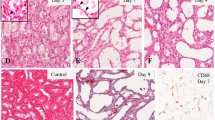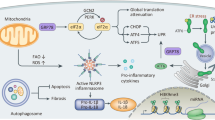Abstract
Mechanism of renal fibrosis leading to end stage kidney remains still a challenge of interest in humans. The pathogenesis of chronic kidney disease is characterized by progressive loss of kidney function and fibrosis. The mechanism of epithelial–mesenchymal transition (EMT) has been predominantly studied in in vitro studies, and we previously demonstrated the EMT of tubular epithelial cells in dogs. In this study, we examined and quantified the modifications of cadherin–catenin complex by immunohistochemistry of E-cadherin and β-catenin and the mesenchymal marker vimentin in 25 dogs with three different spontaneous inflammatory renal diseases. Results showed a significant down-expression of levels of E-cadherin and β-catenin directly correlated with the tubular–interstitial damage (TID). In TID grades 2 and 3, E-cadherin expression was significantly reduced (p < 0.001). β-catenin expression was overall similar to E-cadherin. The mesenchymal-associated protein, vimentin, was de novo identified in tubules within areas of inflammation. In this work, we identified the loss of cadherin or catenin expression as a progressive mechanism in tubulo-interstitial fibrosis, which allows dissociation of structural integrity of renal epithelia and loss of epithelial polarity. The dog might result more significant as model for new therapies.






Similar content being viewed by others
References
Aresu L, Rastaldi MP, Scanziani E, Baily J, Radaelli E, Pregel P, Valenza F (2007) Epithelial-mesenchymal transition (EMT) of renal tubular cells in canine glomerulonephritis. Virchows Arch 451:937–942
Blanco D, Vicent S, Elizegi E, Pino I, Fraga MF, Esteller M, Saffiotti U, Lecanda F, Montuenga LM (2004) Altered expression of adhesion molecules and epithelial-mesenchymal transition in silica-induced rat lung carcinogenesis. Lab Invest 84:999–1012
Bottinger EP (2007) TGF-beta in renal injury and disease. Semin Nephrol 27:309–320
Brunetti B, Sarli G, Preziosi R, Monari I, Benazzi C (2005) E-cadherin and beta-catenin reduction influence invasion but not proliferation and survival in canine malignant mammary tumors. Vet Pathol 42:781–787
Bush KT, Tsukamoto T, Nigam SK (2000) Selective degradation of E-cadherin and dissolution of E-cadherin-catenin complexes in epithelial ischemia. Am J Physiol Renal Physiol 278:F847–F852
Capaldo CT, Macara IG (2007) Depletion of E-cadherin disrupts establishment but not maintenance of cell junctions in Madin-Darby canine kidney epithelial cells. Mol Biol Cell 18:189–200
Chen H, Paradies NE, Fedor-Chaiken M, Brackenbury R (1997) E-cadherin mediates adhesion and suppresses cell motility via distinct mechanisms. J Cell Sci 110:345–356
Cho EA, Patterson LT, Brookhiser WT, Mah S, Kintner C, Dressler GR (1998) Differential expression and function of cadherin-6 during renal epithelium development. Development 125:803–812
Conacci-Sorrell M, Simcha I, Ben-Yedidia T, Blechman J, Savagner P, Ben-Ze’ev A (2003) Autoregulation of E-cadherin expression by cadherin-cadherin interactions: the roles of beta-catenin signaling, Slug, and MAPK. J Cell Biol 163:847–857
Gupta S, Clarkson MR, Duggan J, Brady HR (2000) Connective tissue growth factor: potential role in glomerulosclerosis and tubulointerstitial fibrosis. Kidney Int 58:1389–1399
Hayashida Y, Honda K, Idogawa M, Ino Y, Ono M, Tsuchida A, Aoki T, Hirohashi S, Yamada T (2005) E-cadherin regulates the association between beta-catenin and actinin-4. Cancer Res 65:8836–8845
Hertig A, Verine J, Mougenot B, Jouanneau C, Ouali N, Sebe P, Glotz D, Ancel PY, Rondeau E, Xu-Dubois YC (2006) Risk factors for early epithelial to mesenchymal transition in renal grafts. Am J Transplant 6:2937–2946
Hirohashi S, Kanai Y (2003) E-cadherin mediates adhesion and suppresses cell motility via distinct mechanisms. Cancer Sci 110:345–356
Jinde K, Nikolic-Paterson DJ, Huang XR, Sakai H, Kurokawa K, Atkins RC, Lan HY (2001) Tubular phenotypic change in progressive tubulointerstitial fibrosis in human glomerulonephritis. Am J Kidney Dis 38:761–769
Kalluri R, Neilson EG (2003) Epithelial-mesenchymal transition and its implications for fibrosis. J Clin Invest 112:1776–1784
Kirchner T, Brabletz T (2000) Patterning and nuclear beta-catenin expression in the colonic adenoma-carcinoma sequence. Analogies with embryonic gastrulation. Am J Pathol 157:1113–1121
Kitagawa T, Matsumoto K, Nagafuchi A, Tsukita S, Suzuki H (1999) Co-expression of E-cadherin and alpha-catenin molecules in colorectal cancer. Surg Today 29:511–518
Kreidberg JA, Symons JM (2000) Integrins in kidney development, function, and disease. Am J Physiol Renal Physiol 279:F233–F242
Kwak JM, Min BW, Lee JH, Choi JS, Lee SI, Park SS, Kim J, Um JW, Kim SH, Moon HY (2007) The Prognostic Significance of E-Cadherin and Liver Intestine-Cadherin Expression in Colorectal Cancer. Dis Colon Rectum 50:1873–1880
Lee DB, Huang E, Ward HJ (2006) Tight junction biology and kidney dysfunction. Am J Physiol Renal Physiol 290:F20–F34
Lee JM, Dedhar S, Kalluri R, Thompson EW (2006) The epithelial-mesenchymal transition: new insights in signalling, development, and disease. J Cell Biol 172:973–981
Liu Y (2004) Epithelial to mesenchymal transition in renal fibrogenesis: pathologic significance, molecular mechanism, and therapeutic intervention. J Am Soc Nephrol 15:1–12
Masszi A, Fan L, Rosivall L, McCulloch CA, Rotstein OD, Mucsi I, Kapus A (2004) Integrity of cell-cell contacts is a critical regulator of TGF-beta 1-induced epithelial-to-myofibroblast transition: role for beta-catenin. Am J Pathol 165:1955–1967
Nakajima S, Doi R, Toyoda E, Tsuji S, Wada M, Koizumi M, Tulachan SS, Ito D, Kami K, Mori T, Kawaguchi Y, Fujimoto K, Hosotani R, Imamura M (2004) N-cadherin expression and epithelial-mesenchymal transition in pancreatic carcinoma. Clin Cancer Res 10:4125–4133
Piepenhagen PA, Nelson WJ (1995) Differential expression of cell-cell and cell-substratum adhesion proteins along the kidney nephron. Am J Physiol 269:C1433–C1449
Prozialeck WC, Edwards JR (2007) Cell adhesion molecules in chemically-induced renal injury. Pharmacol Ther 114:74–93
Rastaldi MP, Ferrario F, Giardino L, Dell’Antonio G, Grillo C, Grillo P, Strutz F, Müller GA, Colasanti G, D’Amico G (2002) Epithelial-mesenchymal transition of tubular epithelial cells in human renal biopsies. Kidney Int 62:137–146
Tepass U, Truong K, Godt D, Ikura M, Peifer M (2000) Cadherins in embryonic and neural morphogenesis. Nat Rev Mol Cell Biol 1:91–100
Tian YC, Fraser D, Attisano L, Phillips AO (2003) TGF-beta1-mediated alterations of renal proximal tubular epithelial cell phenotype. Am J Physiol Renal Physiol 285:F130–F142
van Timmeren MM, van den Heuvel MC, Bailly V, Bakker SJ, van Goor H, Stegeman CA (2007) Tubular kidney injury molecule-1 (KIM-1) in human renal disease. J Pathol 212:209–217
Yang J, Liu Y (2001) Dissection of key events in tubular epithelial to myofibroblast transition and its implications in renal interstitial fibrosis. Am J Pathol 159:1465–1475
Zeisberg M, Bonner G, Maeshima Y, Colorado P, Müller GA, Strutz F, Kalluri R (2001) Renal fibrosis: collagen composition and assembly regulates epithelial-mesenchymal transdifferentiation. Am J Pathol 159:1313–1321
Conflict of interest statement
We declare that we have no conflict of interest.
Author information
Authors and Affiliations
Corresponding author
Rights and permissions
About this article
Cite this article
Aresu, L., Rastaldi, M.P., Pregel, P. et al. Dog as model for down-expression of E-cadherin and β-catenin in tubular epithelial cells in renal fibrosis. Virchows Arch 453, 617–625 (2008). https://doi.org/10.1007/s00428-008-0684-8
Received:
Revised:
Accepted:
Published:
Issue Date:
DOI: https://doi.org/10.1007/s00428-008-0684-8




